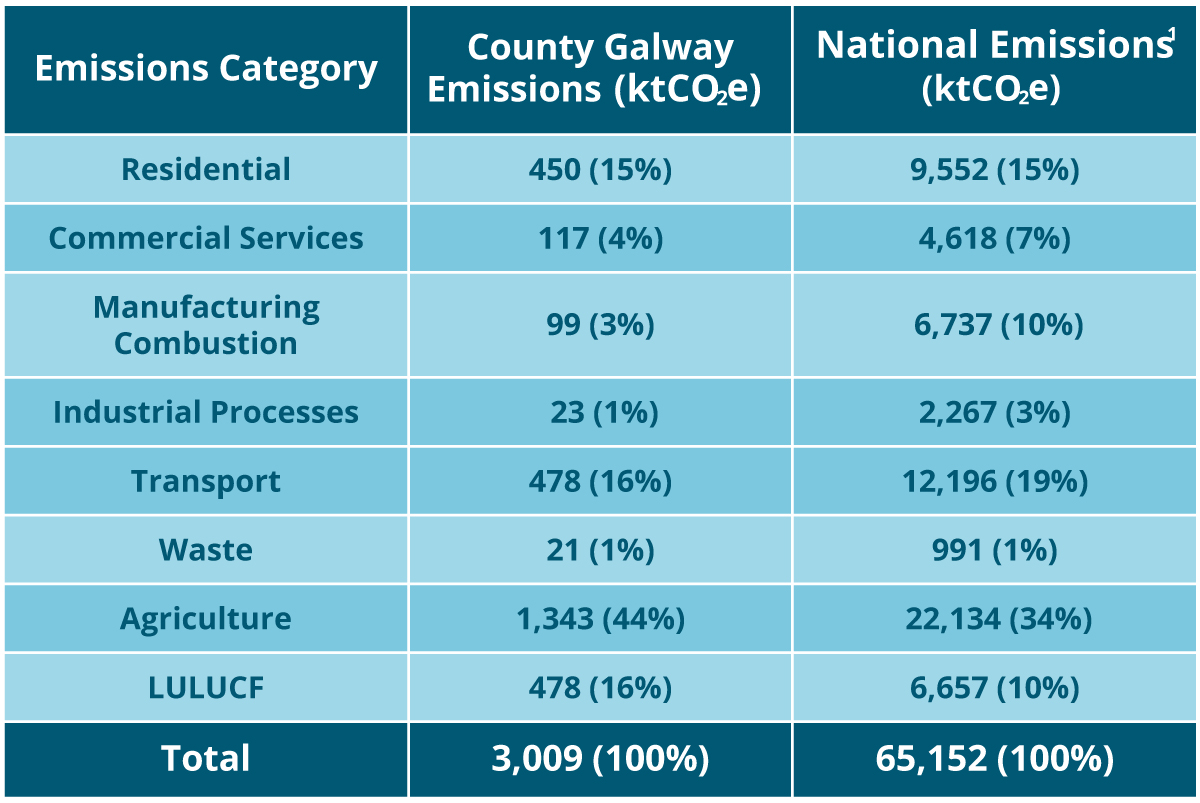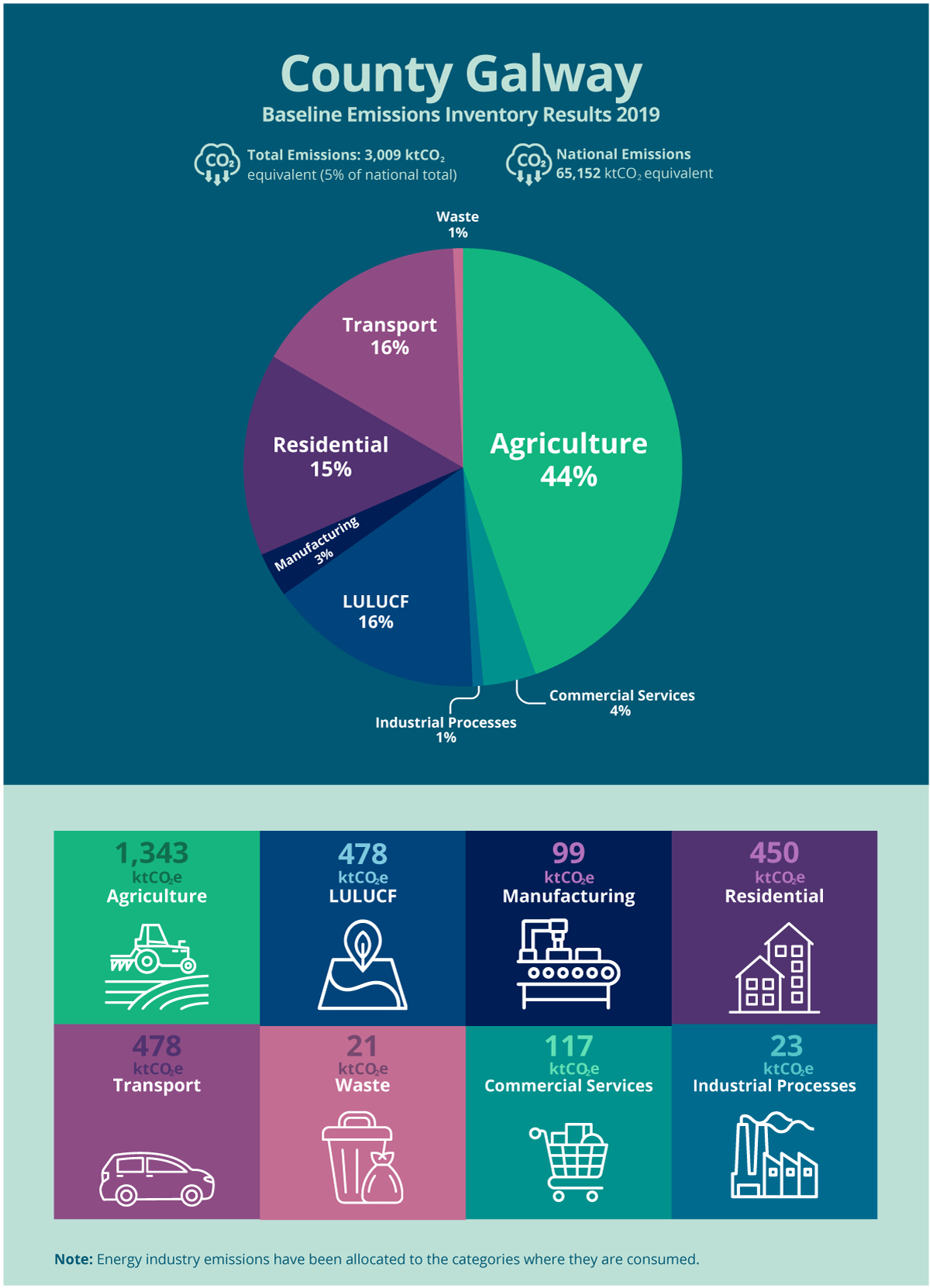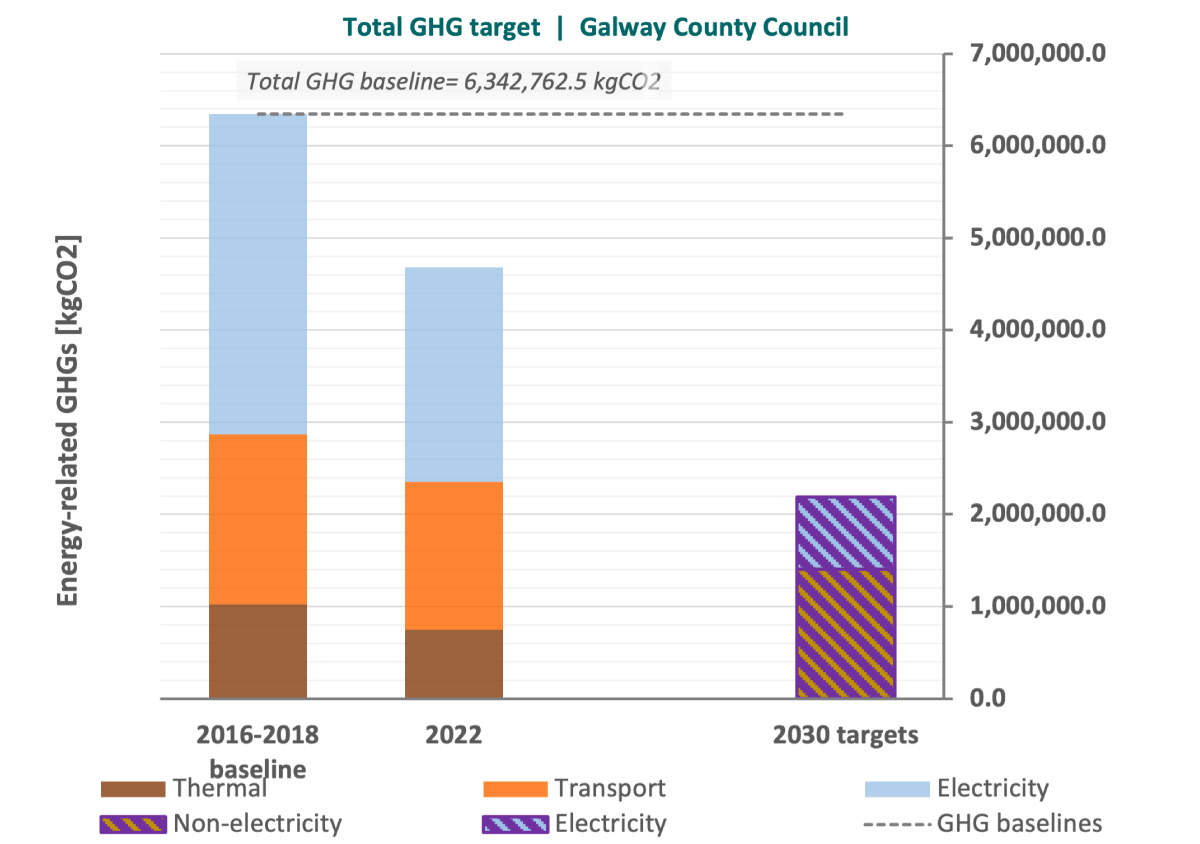3. Evidence Based Climate Action

3.1. Stakeholder Engagement
Stakeholder engagement is a vital component of any Climate Action Plan, as it ensures that the Plan reflects the needs, interests and values of the people who are affected by or involved in the transition to a low-carbon and climate-resilient society. A significant programme of Stakeholder Engagement was undertaken in Spring and Summer 2023. A Climate Action Plan Summary Report was developed to serve as evidence base and an engagement tool.
The Stakeholder Engagement Programme included:
- national sectoral workshops,
- internal department workshops,
- decarbonisation zone meetings and workshop,
- stands and presentations at local festivals and sectoral events,
- public surveys,
- Climate Youth Assembly and other conferences
Galway County Council is also engaged in existing public participation structures and approaches that are bottom-up, local community centred and are outcome focused including Public Participation Networks (PPN), Tidy Towns, Sustainable Energy Communities (SECs) and a range of other programmes and initiatives and communities were consulted via these networks.
Active citizenship requires the will and the opportunity to participate at every level and in every way – to be the arrow; not the target
President Michael D Higgins
Over 200 items of feedback were received from the individuals and community groups via the various means of engagement. This included 177 responses to the Climate, Biodiversity and Heritage Survey, workshop reports and submissions from groups such as Irish Wildlife Trust, An Taisce, Bird Watch Ireland, Tidy Towns Groups, Sustainable Energy Communities, Galway Green Party, the Galway Cycling Campaign, LAWPRO, the Heritage Council, and the National Federation of Group Water Schemes. The submissions and reports were an integral part of the development of the draft actions.
Some findings of note from the Climate, Biodiversity and Heritage Survey are presented below:
- 80% of survey respondents considered it important to set ambitious targets and timelines in the Plan.
-
The areas identified as highest priority for focus in the development of the Plan were:
- Sustainable transport
- Renewable energy
- Energy efficiency
- Water protection
- 91.5% of respondents said they would like to improve the energy efficiency of their homes or businesses and cost was reported as the greatest barrier.
-
Respondents identified that improvements in the following areas would help them to move to avail of more sustainable modes of travel:
- Improved public transport,
- Improved cycle lanes/footpaths,
- Improved safety
- More EV charging points
3.1.1. Youth Engagement
Delivering on our climate ambition requires that the Government and the people of Ireland come together in a strengthened social contract for climate action and the co-creation of real solutions to these challenges
Climate Action Plan 2023
Climate change is a global challenge that will have significant long-term impacts, and young people will inherit the consequences of decisions made today. Engaging with young people in climate planning ensures that their future interests and well-being are considered and was a key aspect of the development of the Plan. Young people can also be an important driver of positive change in their communities.
CASE STUDY – Youth Climate Assembly
In Galway, our ability to engage with young people has been significantly enhanced through the work of SAUTI-Youth (Sustainable Accountability Uniting Tanzanian and Irish Youth) which is an initiative co-funded by the European Union, World Vision Ireland, Youth Work Ireland Galway and World Vision Tanzania. It is a youth led initiative which aims to monitor local government commitments to climate action, in Galway and Tanga (Tanzania). Young people are provided with the skills to monitor their local government’s climate action commitments and spending. Youth are empowered to engage with local authorities to ensure young people’s voices are taken into consideration in decisions which effect their future.
In conjunction with the SAUTI Youth Project and Youth Work Ireland Galway, a Youth Climate Assembly was held in Athenry on the 19th of April 2023. The Assembly was one of the first events of its kind to happen at a local level in Ireland. 57 students from 13 schools across the county attended the event.



Youth Climate Assembly, April 2023
The innovative event provided a space for young people from secondary schools and youth organisations in the county to gather to discuss an issue that is increasingly impacting our planet. The participants were introduced to policies, projects and research being undertaken in The County of Galway to tackle the Climate and Biodiversity Crises. They were encouraged to initiate positive change through their school and/or youth/community group and were also facilitated to develop recommendations to influence and shape local government policies.
The feedback from the event was gathered into a report and their ideas were incorporated into this Plan.
| Key Issues Identified | |
|---|---|
|
|
| Recommended Actions | |||||
|---|---|---|---|---|---|
|
Waste and Circularity |
|||||
| Increase the availability of segregated bins in communities | Encourage local businesses to reduce waste and use sustainable packaging | Provide public water refill stations | |||
|
Transport and Energy |
|||||
| Improve public transport in rural areas and reduce the cost for young people | Improve active travel facilities including cycle lanes, cycle parking and lighting | Support renewable energy while ensuring open communication with communities | |||
| Leadership and Education | |||||
| Provide training and education in relation to climate action, biodiversity, sustainable food | Improve opportunities for engagement with the local authority | ||||
| Biodiversity | |||||
| Carry out actions to protect biodiversity and support the public to do likewise | |||||
Feedback from the attendees included:
“I really enjoyed the Q&A and the way we could express how we feel about climate change, and we learned what we could do to help change Galway for the better”.
“There is a bigger community concerned about climate change than I previously thought. You can combat climate change in any career and there’s a lot of opportunity to get involved”.
“I would love to regularly participate in events like these with like-minded young people”.
“I liked today because I got to learn more about climate change and our economy”
“I enjoyed having my opinions and questions valued”.
3.2. Partnerships
Developing strong partnerships is necessary for transformational change. Galway County Council does not always have direct control in relation to emissions, however, there are many areas where the Council can advocate for necessary actions.
Galway County Council will continue to create and encourage partnerships with businesses, institutions, industries, and organisations to develop and implement climate actions and projects. Galway County Council welcome interested parties to engage in the delivery of the Climate Action Plan. We will also work closely with local authorities in the Atlantic Seaboard North through the Climate Action Regional Office. These partnerships can provide opportunities for collaboration on projects, shared learnings, technical support and leveraging of funding opportunities during the implementation of actions in the Plan. Galway County Council’s efforts in citizen and stakeholder engagement will continue to be supported by the CAROs, the Environmental Protection Agency, the National Dialogue on Climate Action, and other partners.
3.3. Baseline Emissions Inventory
Understanding where our Greenhouse Gas Emissions (GHG) are coming from at a local level provides an evidence base for developing our Climate Action Plan and enables us to identify appropriate local actions. As part of the Climate Action Plan planning process, a baseline GHG emissions inventory was carried out to understand our starting point and how our actions could reduce overall emissions. The report evaluates and determines the baseline GHG emissions from various sectors in the county, including insights into Galway County Council’s own emissions, for the year 2018. The year 2018 was selected nationally as the baseline year to inform this Climate Action Plan. This baseline also aims to raise awareness of climate change and the impact that different sectors within the county have on Ireland's overall GHG emissions.
The sectors included in the county wide analysis are: residential, commercial and industrial, industrial processes, agriculture, transport, waste and wastewater, and land use land use change and forestry (LULUCF). The methodology is based on the Tier 1 'Top- down' Approach defined in Technical Annex C of the Local Authority Climate Action Plan Guidelines. The GHG emissions calculations that inform this report are based on data from Map EIre and Ireland's National Emissions Inventory 2021.
The GHG emissions for the County of Galway in the baseline year were approximately 5% of the national emissions. Overall, the GHG emissions generated in the County of Galway equated to 1,905 ktCO2-eq in the baseline year. The top four sectors in the county in terms of emissions were Agriculture, Transport, LULUCF and Residential producing 44%, 16%, 16% and 15% respectively of the total GHG emissions in the county. As shown in Table 2, emissions are broadly in line with National GHG emissions data although Agriculture and LULUCF are slightly higher as would be expected in a rural county.

Table 3: The GHG emissions for the County of Galway

Figure 3.1: County of Galway Emissions Summary
Agriculture
Agriculture is a vital part of Ireland’s economy, generating 8% of the country’s gross value added and providing over 8.5% of national employment in 2019. Ambitious targets have been set nationally to reduce GHG emissions from the sector by 25% by 2030. Emissions are generated from enteric fermentation, manure and soils management, liming, and the use of fertilisers and urea as well as from the use of energy-intensive machinery and equipment.
Galway is a rural county where Agriculture plays a vital role in underpinning the rural economy. It is a diverse geographic region with dry stock mixed farming and dairy farming dominating in lowland areas, whilst in the mountainous parts suckling, sheep, and mixed farming are common. The dominant greenhouse gas emitted in the sector is Methane, followed by Nitrous Oxide. 57% of Agricultural emissions in the county are from enteric fermentation in cattle.
Residential
Within the Residential Sector, 76% of emissions are from hot water and space heating while electricity consumption accounted for 24%.
Transport
Within the Transport Sector, 57% of the total emissions are from private cars and heavy-duty vehicles and buses account for 27%. Private car usage in the county is high, with 67% of residents relying on personal vehicles. This is primarily attributed to the county's predominantly rural nature with dispersed settlements and a relatively low population density of 42 people per square kilometre.
Land Use, Land Use Change and Forestry (LULUCF)
LULUCF is responsible for emissions as well as carbon sinks. It involves emissions and sequestration within forest land, cropland, grassland, wetlands, settlements and other land types, as well as through the harvesting of wood products. Cropland and forest land were responsible for the removal of 420 ktCO2 equivalents of emissions, whilst grassland, settlements, wetlands, and other land were responsible for emitting 900 ktCO2 equivalents of emissions. County Galway has a wide variety of wetlands, grasslands, and forestry. There is a large variation in soil types in the region with significant areas of peat, rock (grey), brown earth and gleys. When peatlands and wetlands are drained and damaged, it generates emissions.
3.3.1. Galway County Council Emissions and Targets
Galway County Council, along with all public bodies in Ireland must achieve a 51% reduction in energy related GHG emissions and a 50% improvement in energy efficiency by 2030. This target builds on the previous 33%-by-2020 energy efficiency target. Galway County Council must also reduce its GHG emissions by 51% by 2030. The target is a 51% reduction of direct energy-related emissions (thermal and transport consumption), plus projected supply side reductions in indirect energy-related emissions from electricity. This is tracked through the SEAI’s Monitoring and Reporting (M&R) system.
Electricity usage related GHG emissions for the local authority are a result of building and facility electricity usage and public lighting electricity usage. Thermal GHG emissions for the local authority are a result of building and facility space heating. Transport GHG emissions for the local authority are associated from the diesel and petrol usage among the local authority’s vehicles and plant fleet. In the 2016 to 2018 period, the average emissions amounted to 6.3 ktCO2 equivalents. This represents less than 1% of the total emissions for the County. Transport was the highest contributor, accounting for 35% of total emissions. This was followed by public lighting, contributing 30% of total emissions, with thermal contributing 16%.

Figure 3.2: Galway County Council Emissions
A summary of the gap to meeting the 51% greenhouse gas emissions reduction target, and graphical representation of the workload required is outlined in the figure below. Our overall target by 2030 is a reduction of 4.1 kg of CO2e when compared to the 2016-18 baseline. A significant proportion of the reduction to date is due to public lighting upgrades.

Figure 3.3: Total GHG target Galway County Council
The requirements for public sector bodies is to lead by example in the Climate Action Plan, and a commitment by local authorities to monitor, evaluate and report annually on the implementation of activities contained in the Local Authority Climate Action Charter, means that there is a need to measure, demonstrate and improve climate action performance to support national climate ambitions to 2050.
The following chapter will identify climate actions focused at achieving Galway County Council’s Climate targets.

